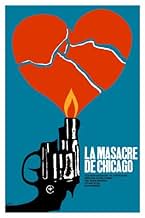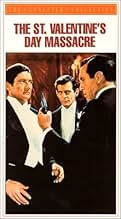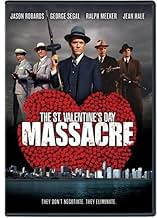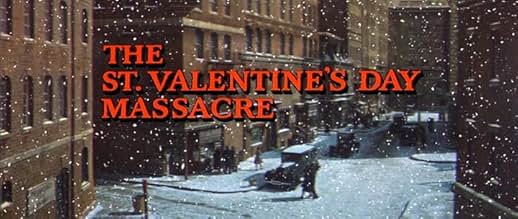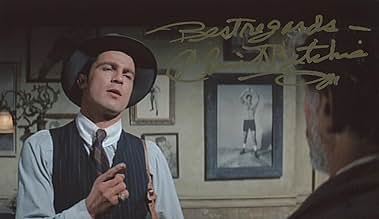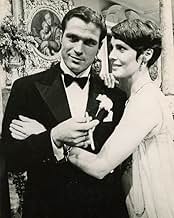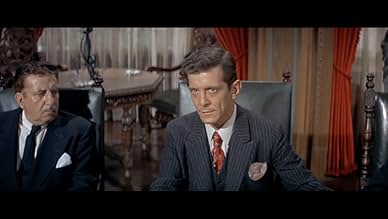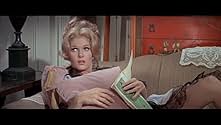IMDb-BEWERTUNG
6,6/10
4930
IHRE BEWERTUNG
Al Capone's Valentinstag-Überraschung für die rivalisierende Bugs Moran-Bande 1929 in Chicago.Al Capone's Valentinstag-Überraschung für die rivalisierende Bugs Moran-Bande 1929 in Chicago.Al Capone's Valentinstag-Überraschung für die rivalisierende Bugs Moran-Bande 1929 in Chicago.
Joe Turkel
- Jake 'Greasy Thumb' Guzik
- (as Joseph Turkel)
Handlung
WUSSTEST DU SCHON:
- WissenswertesFor the massacre scene in the garage, the actors playing the slain gangsters were shown photos and directed as how to fall so their positions were identical to the real photos of the massacre. Two actors bumped together on the way down. After studying photographs they realized they had fallen and collided in the exact way the slain gangsters had fallen and had landed in the correct positions.
- Zitate
Reporter: Y'know some are sayin' that it really was the cops who shot those men.
Bugs Moran: You must be new to this town, mister. Only Al Capone kills like that.
- VerbindungenEdited into Capone (1975)
Ausgewählte Rezension
It took me a while before I really appreciated this film. Despite its flaws, this is probably the most serious, accurate, and restrained treatment on the subject you're ever going to get without watching a straight-out documentary. What you have is sort of a "docudrama" on the infamous St. Valentine's Massacre, and the events leading up to it.
Not that the film ST. VALENTINE'S DAY MASSACRE takes itself too seriously. It doesn't, but all of the over-the-top acting merely enhances the product. There are still some inaccuracies but the story adheres so closely to the actual facts that these discrepancies are easily forgiven. The violence shown might have been considered sensational in 1967, and this was most probably the intent, but it's pretty tame by today's standards. And if it falls short of being a great film, it's a near miss rather than one by a mile.
In this dramatization of the final showdown between the South Side and North Side gangs for control of Chicago's underworld in 1929, Jason Robards takes center stage as Al Capone. He might have been much older and looked nothing like the real Capone but then so what. As they say, you want an interpretation and not an impersonation. His histrionic performance, with all of its eye-rolling and exaggeration, strikes just the right note and does its part to help keep things moving throughout. This was an actor who knew what he was doing, and exactly how he should play it in this instance.
But it takes a while for Capone to show up, finally seen casually arriving in a limousine on his way to a board meeting with his underlings. The first hood to show up on screen is played (some could say overplayed) by George Segal as Pete Gusenberg, a member of the rival gang, who proceeds to intimidate a bar-owner. Actually, Segal gives a rather convincing performance as a very smug, arrogant thug who enjoys pushing people around, and acting like he's one bad dude, with guns and a gang to back him up.
A very effective technique employed throughout the film, provided by narrator Paul Frees, is the frequent voiceover commentary on various characters. Information is given, such as that the individual was born on this or that date, at whatever place, something about his background, and his place in the particular gang, etc. (often including his time of death as well). Not only does this provide an easily-understood guide for who's who, but it helps to get the viewer involved with these characters however unsympathetic or unsavory they might be.
In brief but well-played roles, on the Capone side, there's Paul Richards as Charlie Fischetti, Joseph Turkel as Jake Guzik, and Harold Stone as Frank Nitti, with a more conspicuous role played by Clint Richie as Jack McGurn, who gets put in charge of organizing the title massacre. That particularly bloody episode was designed to rid Capone of his archenemy and chief rival, George "Bugs" Moran, capably played by tough-talking Ralph Meeker. Moran was the head of the North Side gang, and in flashback scenes we're shown what befell Moran's two predecessors, Dion O'Bannion (played by John Agar) and Hymie Weiss (played by Reed Hadley).
The rest of the cast is made up of many fine actors, some familiar and others less so. Among the unlucky seven who have an appointment up against a certain garage wall, besides Segal's Pete Gusenberg, included are David Canary as Pete's brother Frank, Kurt Krueger as Moran's top lieutenant, Milton Frome as the gang's accountant, Joseph Campanella as a low-level employee, Bruce Dern as a mechanic, and Mickey Deems as a hanger-on. Not to be overlooked is the always excellent Frank Silvera as Nick Sorello, a not completely innocent pawn used in trying to set up Moran.
Almost every actor with a speaking role gets at least one good scene and a chance to shine, from the major actors right on down to several of the minor supporting players. An attempt is made to show some of the camaraderie and interaction among the members of each gang. The careful planning of the "hit" is laid out, including an amusing scene where two gunmen, posing as musicians, are renting a room from a wary landlady.
Such details add to the plot and the characterizations, with keen attention being paid to recreating a 1920s atmosphere, and don't forget all of the various gunplay and assorted mayhem along the way, leading up to the fateful massacre. They even throw in a completely superfluous fight between Gusenberg (Segal) and his girlfriend over a fur coat. Since it's only a brief rest from the action, and we get to rest our eyes on Jean Hale, then what's the harm. Enjoy this trip back in time to gangland Chicago.
Not that the film ST. VALENTINE'S DAY MASSACRE takes itself too seriously. It doesn't, but all of the over-the-top acting merely enhances the product. There are still some inaccuracies but the story adheres so closely to the actual facts that these discrepancies are easily forgiven. The violence shown might have been considered sensational in 1967, and this was most probably the intent, but it's pretty tame by today's standards. And if it falls short of being a great film, it's a near miss rather than one by a mile.
In this dramatization of the final showdown between the South Side and North Side gangs for control of Chicago's underworld in 1929, Jason Robards takes center stage as Al Capone. He might have been much older and looked nothing like the real Capone but then so what. As they say, you want an interpretation and not an impersonation. His histrionic performance, with all of its eye-rolling and exaggeration, strikes just the right note and does its part to help keep things moving throughout. This was an actor who knew what he was doing, and exactly how he should play it in this instance.
But it takes a while for Capone to show up, finally seen casually arriving in a limousine on his way to a board meeting with his underlings. The first hood to show up on screen is played (some could say overplayed) by George Segal as Pete Gusenberg, a member of the rival gang, who proceeds to intimidate a bar-owner. Actually, Segal gives a rather convincing performance as a very smug, arrogant thug who enjoys pushing people around, and acting like he's one bad dude, with guns and a gang to back him up.
A very effective technique employed throughout the film, provided by narrator Paul Frees, is the frequent voiceover commentary on various characters. Information is given, such as that the individual was born on this or that date, at whatever place, something about his background, and his place in the particular gang, etc. (often including his time of death as well). Not only does this provide an easily-understood guide for who's who, but it helps to get the viewer involved with these characters however unsympathetic or unsavory they might be.
In brief but well-played roles, on the Capone side, there's Paul Richards as Charlie Fischetti, Joseph Turkel as Jake Guzik, and Harold Stone as Frank Nitti, with a more conspicuous role played by Clint Richie as Jack McGurn, who gets put in charge of organizing the title massacre. That particularly bloody episode was designed to rid Capone of his archenemy and chief rival, George "Bugs" Moran, capably played by tough-talking Ralph Meeker. Moran was the head of the North Side gang, and in flashback scenes we're shown what befell Moran's two predecessors, Dion O'Bannion (played by John Agar) and Hymie Weiss (played by Reed Hadley).
The rest of the cast is made up of many fine actors, some familiar and others less so. Among the unlucky seven who have an appointment up against a certain garage wall, besides Segal's Pete Gusenberg, included are David Canary as Pete's brother Frank, Kurt Krueger as Moran's top lieutenant, Milton Frome as the gang's accountant, Joseph Campanella as a low-level employee, Bruce Dern as a mechanic, and Mickey Deems as a hanger-on. Not to be overlooked is the always excellent Frank Silvera as Nick Sorello, a not completely innocent pawn used in trying to set up Moran.
Almost every actor with a speaking role gets at least one good scene and a chance to shine, from the major actors right on down to several of the minor supporting players. An attempt is made to show some of the camaraderie and interaction among the members of each gang. The careful planning of the "hit" is laid out, including an amusing scene where two gunmen, posing as musicians, are renting a room from a wary landlady.
Such details add to the plot and the characterizations, with keen attention being paid to recreating a 1920s atmosphere, and don't forget all of the various gunplay and assorted mayhem along the way, leading up to the fateful massacre. They even throw in a completely superfluous fight between Gusenberg (Segal) and his girlfriend over a fur coat. Since it's only a brief rest from the action, and we get to rest our eyes on Jean Hale, then what's the harm. Enjoy this trip back in time to gangland Chicago.
Top-Auswahl
Melde dich zum Bewerten an und greife auf die Watchlist für personalisierte Empfehlungen zu.
- How long is The St. Valentine's Day Massacre?Powered by Alexa
Details
- Erscheinungsdatum
- Herkunftsland
- Sprachen
- Auch bekannt als
- The St. Valentine's Day Massacre
- Drehorte
- Desilu Studios - 9336 W. Washington Blvd., Culver City, Kalifornien, USA(street scenes, garage - exteriors)
- Produktionsfirma
- Weitere beteiligte Unternehmen bei IMDbPro anzeigen
Box Office
- Budget
- 1.000.000 $ (geschätzt)
- Laufzeit1 Stunde 40 Minuten
- Farbe
- Seitenverhältnis
- 2.35 : 1
Zu dieser Seite beitragen
Bearbeitung vorschlagen oder fehlenden Inhalt hinzufügen

Oberste Lücke
By what name was Chicago-Massaker (1967) officially released in India in English?
Antwort

